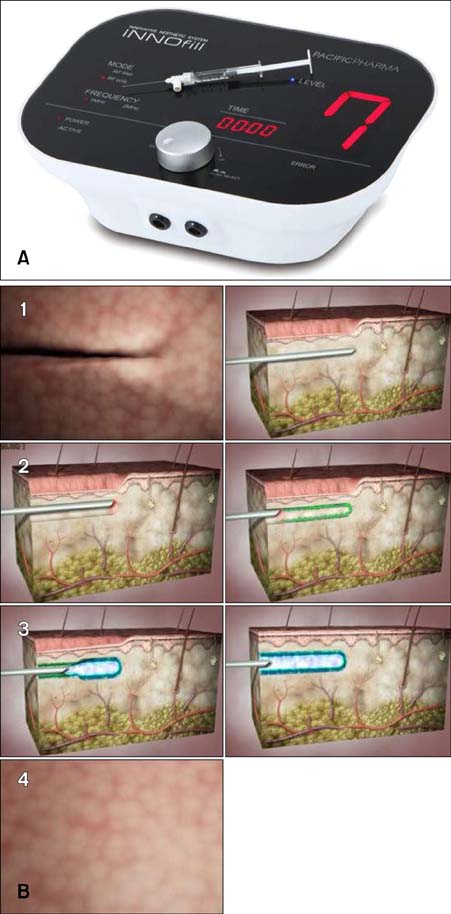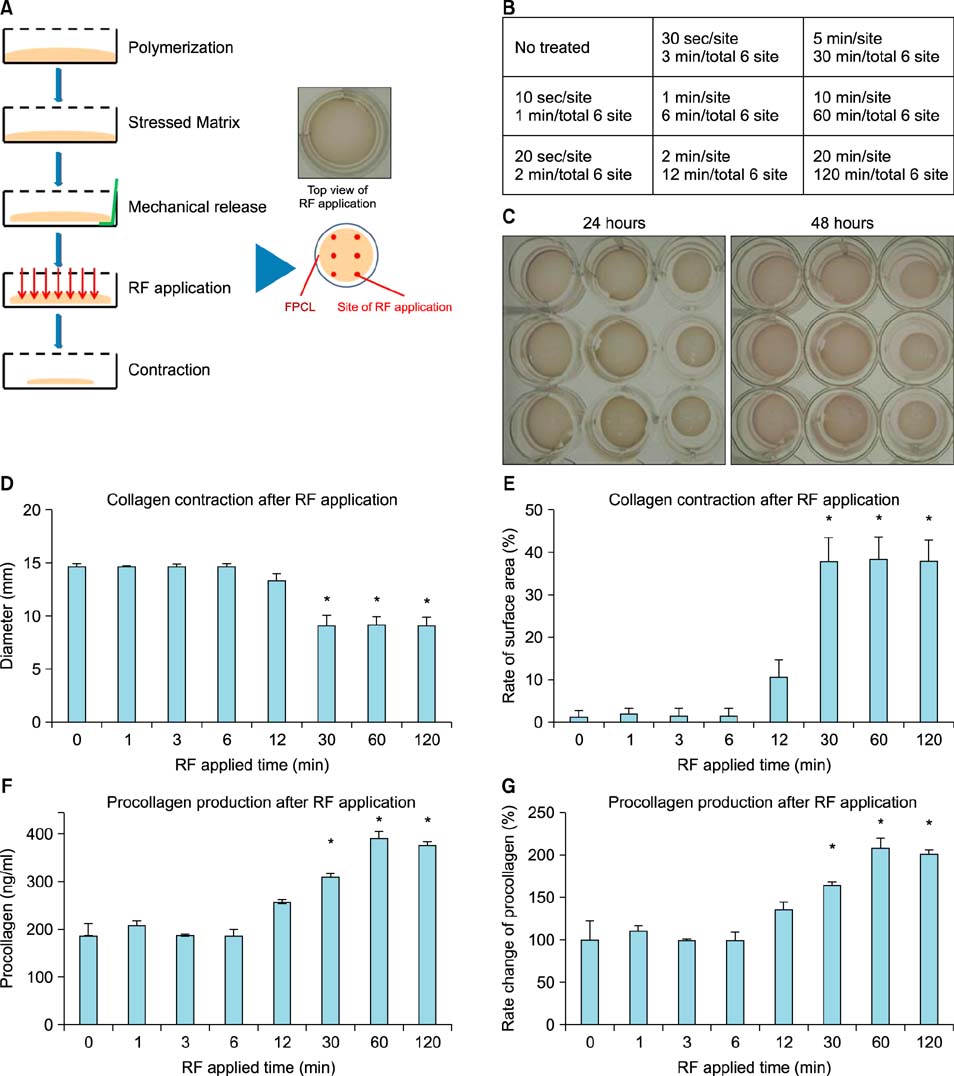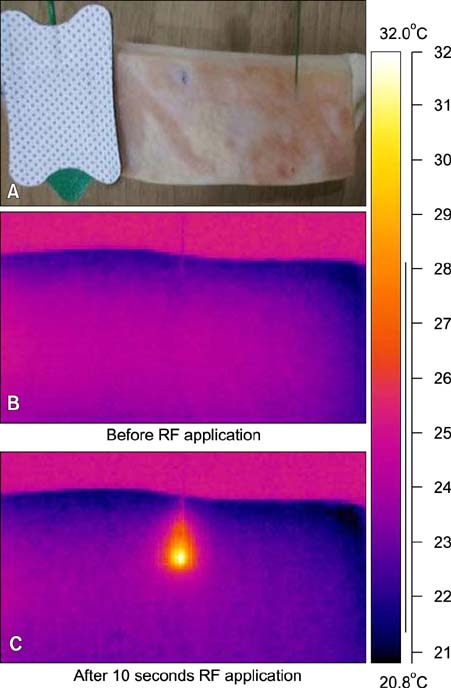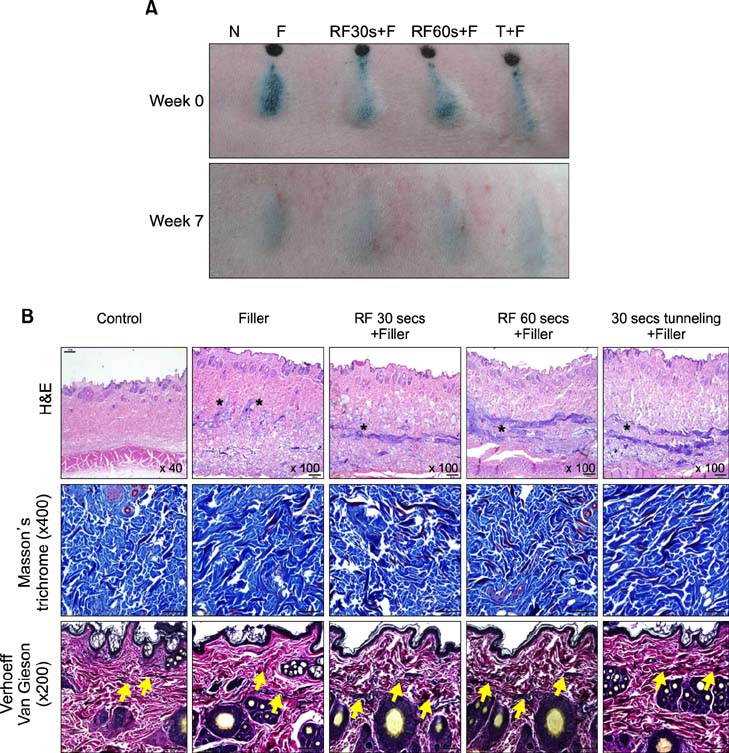Ann Dermatol.
2014 Aug;26(4):447-456. 10.5021/ad.2014.26.4.447.
The Efficacy, Longevity, and Safety of Combined Radiofrequency Treatment and Hyaluronic Acid Filler for Skin Rejuvenation
- Affiliations
-
- 1Aesthetic Research Team, Amore Pacific Corporation Research and Development Center, Yongin, Korea.
- 2Department of Dermatology, Chung-Ang University College of Medicine, Seoul, Korea. beomjoon@unitel.co.kr
- KMID: 2265584
- DOI: http://doi.org/10.5021/ad.2014.26.4.447
Abstract
- BACKGROUND
Recent advances in hyaluronic acid (HA) fillers and radiofrequency (RF) devices have been made in the context of skin rejuvenation and cosmetic surgery. Moreover, combination regimens with both techniques are currently being developed.
OBJECTIVE
The present study was designed to examine the clinical and histologic effects of a new needle that incorporates an RF device for HA injections.
METHODS
A new intradermal needle RF device (INNOfill; Pacific Pharma, Korea) was assessed in the present study. In the animal arm, procollagen production was measured by using enzyme-linked immunosorbent assay, the filler volume was quantified by incorporating a dye with filler, and the filler distribution was assessed through the changes in tissue structure. In the human arm, the efficacy of the combination regimen was assessed by using the wrinkle severity rating scale (WSRS).
RESULTS
In the animal study, RF treatment increased procollagen production in a time-dependent fashion. The total volume was significantly increased with the RF treatment when compared with the filler injections alone, and lasted for up to 7 weeks after treatment. Additionally, the filler distribution was reduced in animals treated with RF when compared with the untreated group. In the human study, the nasolabial folds of subjects treated with RF before filler injections exhibited a significantly greater change in the WSRS score from baseline when compared with the nasolabial folds treated with filler injections alone.
CONCLUSION
A new device incorporating RF treatment before HA filler injection may represent a biocompatible and long-lasting advance in skin rejuvenation.
Keyword
MeSH Terms
Figure
Cited by 2 articles
-
A Randomized, Evaluator-Blinded, Split-Face Comparison Study of the Efficacy and Safety of a Novel Mannitol Containing Monophasic Hyaluronic Acid Dermal Filler for the Treatment of Moderate to Severe Nasolabial Folds
Byung Wook Kim, Ik Jun Moon, Woo Jin Yun, Bo Young Chung, Sang Duck Kim, Ga-Young Lee, Sung Eun Chang
Ann Dermatol. 2016;28(3):297-303. doi: 10.5021/ad.2016.28.3.297.Usefulness of Monopolar Thermal Radiofrequency Treatment for Periorbital Wrinkles
Song Hee Han, Yeong Min Yoon, Yang Won Lee, Yong Beom Choe, Kyu Joong Ahn
Ann Dermatol. 2018;30(3):296-303. doi: 10.5021/ad.2018.30.3.296.
Reference
-
1. El-Domyati M, Attia S, Saleh F, Brown D, Birk DE, Gasparro F, et al. Intrinsic aging vs. photoaging: a comparative histopathological, immunohistochemical, and ultrastructural study of skin. Exp Dermatol. 2002; 11:398–405.
Article2. el-Domyati M, el-Ammawi TS, Medhat W, Moawad O, Brennan D, Mahoney MG, et al. Radiofrequency facial rejuvenation: evidence-based effect. J Am Acad Dermatol. 2011; 64:524–535.
Article3. Goldman MP, Alster TS, Weiss R. A randomized trial to determine the influence of laser therapy, monopolar radiofrequency treatment, and intense pulsed light therapy administered immediately after hyaluronic acid gel implantation. Dermatol Surg. 2007; 33:535–542.
Article4. Buck DW 2nd, Alam M, Kim JY. Injectable fillers for facial rejuvenation: a review. J Plast Reconstr Aesthet Surg. 2009; 62:11–18.
Article5. Beasley KL, Weiss MA, Weiss RA. Hyaluronic acid fillers: a comprehensive review. Facial Plast Surg. 2009; 25:86–94.
Article6. Hantash BM, Ubeid AA, Chang H, Kafi R, Renton B. Bipolar fractional radiofrequency treatment induces neoelastogenesis and neocollagenesis. Lasers Surg Med. 2009; 41:1–9.
Article7. Day DJ, Littler CM, Swift RW, Gottlieb S. The wrinkle severity rating scale: a validation study. Am J Clin Dermatol. 2004; 5:49–52.8. Kim KH, Geronemus RG. Nonablative laser and light therapies for skin rejuvenation. Arch Facial Plast Surg. 2004; 6:398–409.
Article9. England LJ, Tan MH, Shumaker PR, Egbert BM, Pittelko K, Orentreich D, et al. Effects of monopolar radiofrequency treatment over soft-tissue fillers in an animal model. Lasers Surg Med. 2005; 37:356–365.
Article10. Shumaker PR, England LJ, Dover JS, Ross EV, Harford R, Derienzo D, et al. Effect of monopolar radiofrequency treatment over soft-tissue fillers in an animal model: part 2. Lasers Surg Med. 2006; 38:211–217.
Article11. Alam M, Levy R, Pajvani U, Ramierez JA, Guitart J, Veen H, et al. Safety of radiofrequency treatment over human skin previously injected with medium-term injectable soft-tissue augmentation materials: a controlled pilot trial. Lasers Surg Med. 2006; 38:205–210.
Article12. Park KY, Park MK, Li K, Seo SJ, Hong CK. Combined treatment with a nonablative infrared device and hyaluronic acid filler does not have enhanced efficacy in treating nasolabial fold wrinkles. Dermatol Surg. 2011; 37:1770–1775.
Article13. Kim JE, Sykes JM. Hyaluronic acid fillers: history and overview. Facial Plast Surg. 2011; 27:523–528.
Article14. Turlier V, Rouquier A, Black D, Josse G, Auvergnat A, Briant A, et al. Assessment of the clinical efficacy of a hyaluronic acid-based deep wrinkle filler using new instrumental methods. J Cosmet Laser Ther. 2010; 12:195–202.
Article15. Belda JI, Artola A, García-Manzanares MD, Ferrer C, Haroun HE, Hassanein A, et al. Hyaluronic acid combined with mannitol to improve protection against free-radical endothelial damage: experimental model. J Cataract Refract Surg. 2005; 31:1213–1218.
Article16. Atiyeh BS, Dibo SA. Nonsurgical nonablative treatment of aging skin: radiofrequency technologies between aggressive marketing and evidence-based efficacy. Aesthetic Plast Surg. 2009; 33:283–294.
Article17. Arnoczky SP, Aksan A. Thermal modification of connective tissues: basic science considerations and clinical implications. J Am Acad Orthop Surg. 2000; 8:305–313.
Article
- Full Text Links
- Actions
-
Cited
- CITED
-
- Close
- Share
- Similar articles
-
- Hyaluronidase: An overview of its properties, applications, and side effects
- Delayed skin discoloration spreading in the direction of gravity after injection of hyaluronic acid dermal fillers in both nasolabial folds
- A Case of Delayed Hypersensitivity Reaction due to Hyaluronic Acid (Restylane(R))
- Facial Pseudocyst Caused by Hyaluronic Acid Filler Injection: A Case Report
- Comparison of the efficacy and safety between a new monophasic hyaluronic acid filler and a biphasic hyaluronic acid filler in correcting facial wrinkles






